The same week that calls for better, faster, more frequent bus service made the front page of the Willamette Week, TriMet says they plan to make a major announcement about their Division Transit Project.
The $175 million project aims to create higher quality bus service between downtown Portland and Gresham along Division Street. Instead of a dedicated lane for bus users (which TriMet says isn’t possible because there are too many car users and, “Reducing lanes on Division for a dedicated bus lane would very likely result in traffic diversion to other streets and significant delay”) TriMet will hope to reduce travel times by up to 20 percent with longer (articulated) buses, multiple door boarding, signal priority, new station designs, and a host of infrastructure updates. To decrease wait times, buses will run every 12 minutes during peak hours.
Advertisement

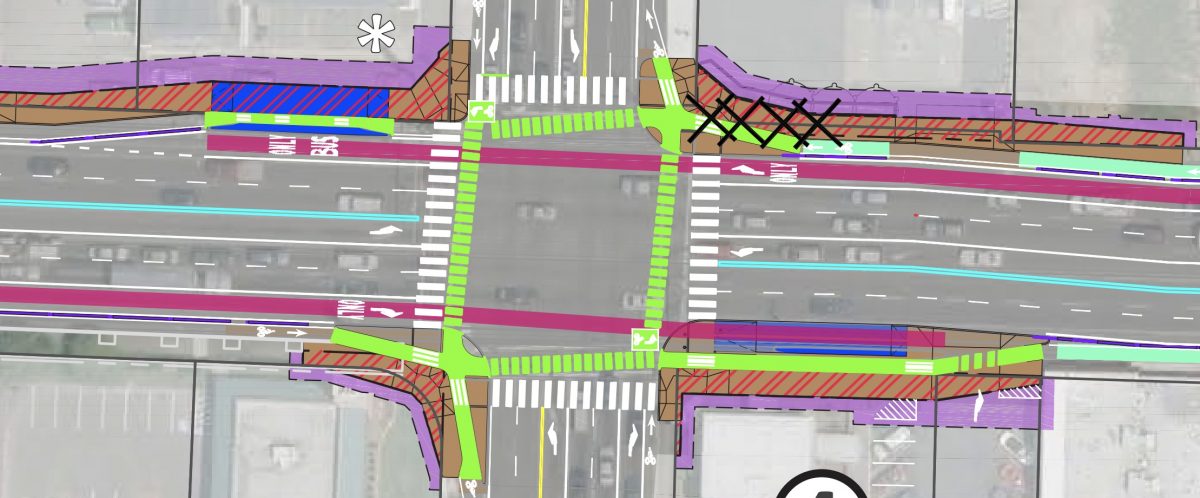
TriMet’s project will coordinate with a City of Portland project that will bring further changes including: protected bike lanes, protected intersections, better lighting, new traffic signals, and safer crossings.
Half of the funding for the project — about $87 million — comes from a Federal Transit Administration grant that was awarded in April 2019.
TriMet is hosting an event for local media on Thursday (1/23) that will include “an exciting announcement” from the FTA. Once the project breaks ground, the new service is expected to be ready by 2022.
— Jonathan Maus: (503) 706-8804, @jonathan_maus on Twitter and jonathan@bikeportland.org
— Get our headlines delivered to your inbox.
— Support this independent community media outlet with a one-time contribution or monthly subscription.


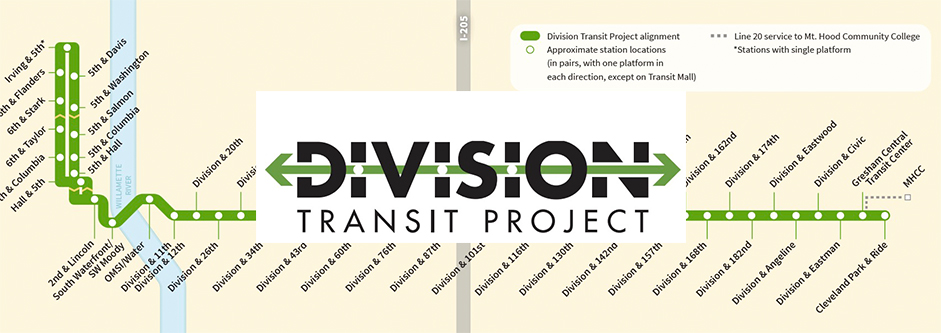
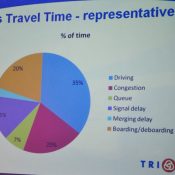
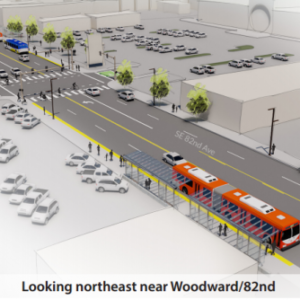
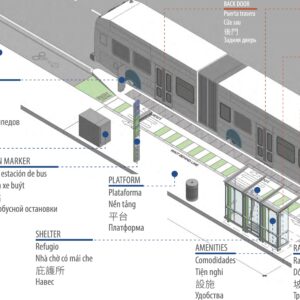

Thanks for reading.
BikePortland has served this community with independent community journalism since 2005. We rely on subscriptions from readers like you to survive. Your financial support is vital in keeping this valuable resource alive and well.
Please subscribe today to strengthen and expand our work.
It would be really nice if Trimet would actually advocate for the best solution and then back down if the political will to do it couldn’t be found, rather than starting at the point of a deep compromise and then often it seems backsliding further from that. The best solution for transit users here is clearly a dedicated lane, but if the agency in charge of providing good solutions for transit users won’t even advocate for it then how can we ever expect to get there. I am very concerned that what we are going to get without dedicated ROW will be similar to what happens during rush hour to the 72, instead of a bus every 12-15 minutes we will see 3 buses showing up every 36-45 minutes, and that is not frequent service…
Your concern certainly isn’t going to be helped by the fact that the Division Transit Project is going to cross a busy freight railway at-grade.
Don’t fret! TriMet is buying Union Pacific some expensive switching equipment that will solve a small portion of the problem.
But they couldn’t afford simple railroad crossing gates for peds and cyclists back when they were asked to provide them???
I’m wondering if the FTA announcement tomorrow will be related to that crossing. I know Brooklyn Yards has said they need $$ to upgrade their switching system so maybe TriMet got FTA to fund it?
I could see how that could maybe reduce the number times a freight train is stopped and blocking the crossing. I don’t see how it can deal with the problem that freight trains are really long, and therefore take a long time to move through the crossing even when traveling at line speed.
Exactly. I don’t much care about who pays for the switch (aside from my general discomfort of the public paying for private infrastructure), but Trimet seems to think it’s the panacea that will make this project work, and I think they’re wrong.
Yeah, they need a roadway underpass there, maybe another $25 mil.
I was thinking “cheapest” where you said “best,” but it’s the same thing. Existing stops, boarding doors, and buses, work great in their own lane. Then you run more buses, is all. And since they’re the same buses as everywhere else, you have no trouble finding enough buses to run, because you can run any bus, not to mention park it in the same (size) spot, and use the same skills belonging to the same mechanics, and the same stock of parts, to maintain it.
This solution amounts to paying extra and inviting problems to preserve car space, so should be viewed as a car project, not a transit project. “With friends like these…”
TriMet is masterful at creating the illusion of progress.
Just don’t ask it to deliver.
Unfortunately the protected intersection at 122nd and Division no longer looks like what was shown in May of last year. It will have protection at the northeast and southwest corner, but only bike boxes at the northwest and southeast corners:
https://trimet.org/division/openhouse/pdf/2019fall/central.pdf
The amount of protection will also feel relatively low. There will be long stretches (often a block or more) where the only protected is from a painted buffer. Sometimes this because of the high number of driveways, a problem that isn’t easy to solve; other times it’s not at all clear to me why physical protection couldn’t have been provided.
It’s definitely going to be an improvement over the status quo, but it will be very far away from being a low stress street to cycle on.
WW says almost all us dedicated bus riders are well satisfied, but we would like more lines and shorter intervals. Only those who rarely or never buses dislike them.
Also, WW says TriMet’s biggest problem for expansion of bus service is not money, but inability to hire drivers.
Yeah, that’s a nationwide problem. In most cases, it’s not the lack of money for drivers or low pay, though that is an issue for some systems, but rather finding any and enough drivers who are trained and qualified to drive huge buses and who are willing to deal with customers in a friendly way, including sometimes rude or very nasty people. Apparently Uber and other alternative services are more profitable for drivers who might have previously (say 15 years ago) driven for the local transit agency. Schools are having an even harder time finding drivers, often asking teachers to work overtime.
Not a matter of hiring new bus drivers, it’s a matter of retention.
All drivers start PT making $14/hr and working split shifts. it’s absurd really. Add on top of that a brutal, highly hierarchical and impersonal management style intended to sow fear and discord among unionized workers and you have a pretty toxic work environment, to say nothing of the customers.
TriMet is stuck in an old-school management by fear business model and other techniques proven to not work in the last century when what they really need is dynamic and vibrant culture of teamwork and collaboration attracting and retaining the best workers.
The accountants are looking forward to unionized robot drivers and A.I. supervisors. Meanwhile, could TriMet outsource to international corporate entities who specialize in running public transit systems while making their unionized employees happy, like the Big 5 of TransDev, Keolis, First Transit, National Express, and RAT-P?
It’s going to be great when Trimet’s new premier high-performance showcase diesel bus gets stuck behind a freight train for 45 minutes making everyone late for work. TriMet says that “only” 10% of their buses will be thusly affected… which means if you use the bus to get to and from work/school, you’re going to get stuck an average of once a week.
I really want this project to work, but there are so many problems with its fundamental design that I can’t see how it will. Trimet needs to take a deep breath and go back to the drawing board.
We can do better.
I would like to know what percentage of riders will be impacted. If the delays happen often at times like the rush hour commute but rarely late at night it is entirely possible that far more than 10% of riders will be delayed even though only 10% of buses are delayed.
And let’s not forget the cost. Is this project really worth $175M?
Do you mean as opposed to a couple of extra flow lanes on I-5 near the Rose Quarter for $750 million?
I don’t think that’s a good investment either. It will be a truly impressive bus line if it is $175M better than the existing #2.
Diesel buses? They aren’t going to use electric buses like how the rest of the world has been going?
30,000 electric buses being added in China per month. They have now over 400,000 electric buses in service.
https://www.bloomberg.com/news/articles/2019-05-15/in-shift-to-electric-bus-it-s-china-ahead-of-u-s-421-000-to-300
By going diesel, this line is going to cost a lot of $$$ to run compared to an electric MAX line. This transit line is already decades out of date before construction even begins.
I haven’t dug into details but does anyone know if street lighting will be added? These streets out here are dark as hell. You’ve got parking, bike lane, travel lane, travel lane, middle lane, travel lane, travel lane, bike lane, parking. That’s wide. Having street lights on one side of the street isn’t sufficient. Also, it seems like there is more space between the lights we do have. Could be making that up but it often feels that way. Admittedly, as I get older my night eyes ain’t what they used to be.
Apologies if this info is staring me in the face…I’m on lunch at work and have limited goof off time.
>>> To decrease wait times, buses will run every 12 minutes during peak hours. <<<
Decrease? The #2 bus currently runs more frequently than this, with headways as low as 7-8 minutes at some times of the day.
https://trimet.org/schedules/w/t1002_1.htm
Not in East Portland it doesn’t.
Check the schedule I linked to. I think you’ll find my comment applies to East Portland.
The #4 is now the #2. Interesting. When did that happen?
About 6 months ago; they wanted to decouple Fessenden bus service from Division, which probably makes sense on some level.
That quote is from Jonathan’s article and appears to be misleading: the project page says “with buses running every 12 minutes and more often during peak hours.”
Reminds me of the 95 Express bus line in Vancouver BC (runs downtown to SFU Burnaby). No dedicated lane, which means the bus constantly leap frogs out into traffic, around parallel parked cars, and back into the travel lane every time a bus departs from a stop. In the graphic above (122nd), are car parking space removed? If yes, the bus still appears to be forced into the shared travel lane. Is there a new traffic lighting system (for the whole route) that somehow gives the bus priority in every instance where the bus has to move back into a shared lane?
The 95-B line is now the R5 and is part of the new rapid bus network in Vancouver. I just passed a stop today (up here visiting) and they have GREAT new signage and new lane/signal priority. Would love to see this in Portland.
https://www.translink.ca/Plans-and-Projects/RapidBus-Program.aspx
https://www.translink.ca/Plans-and-Projects/RapidBus-Program/R5-Hastings-St.aspx
Peak morning service is a bus every 4-5 minute and late night weekends are every 15 minutes.
I first got involved in this project as a PSU MURP student in 2000, as a BRT to Damascus. Now they are doing it! Woohoo!
This is not a BRT project! Enhanced Transit appears to be the preferred description.
A central city higher capacity line on division will be useful. With all the solar, wind, and battery advancements the future will be larger vehicles with intelligent software. This can result in certain corridors getting increased capacity per unit. However, street size is limited and private cars will forever impede on a larger capacity public transit unit (unless limited). The decision is not larger buses but large buses that run on roads which are not subject to dramatic demand fluctuations.
What a waste of money that would be better spend on an extension of the trolly line or MAX.
Yes, that was discussed early on. It appears that a major fresh-water aqueduct runs under a goodly portion of outer Division and there was a concern that rail would upset things. The logical thing would be to move that pipe, of course, but then some inter-agency politics would be played out that certain agencies wanted to avoid (or defer.) As a rule, logic is best avoided for transportation projects. Just as the point of travel is not arrive, the point of transportation implementation is to employ transportation personnel.